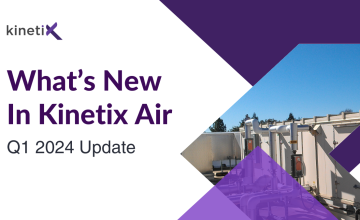Rising energy costs, net-zero regulations and enhanced air quality regulations are set to drive new levels of demand for custom Air Handling Units (AHUs) for commercial and institutional developments and retrofits. But with inflation eating into margins and capacity already maxed out for many manufacturers, who will come out on top in this new competitive landscape? If you are in the industry, you already know that current operational practices will limit efficiency gains. It’s clear that organizations that keep with current SOPs and simply try to scale up production will fall behind. To meet this new demand and actually capitalize on it, AHU manufacturers need to re-engineer their process from design and sales through production and all the way to delivery and support. They need to streamline collaboration, eliminate rework, and minimize all the friction points that are just considered “the way things are done” today.
Are You Competitive Enough to Capitalize on New Demand?
This new demand is going to shake up the industry. Up until today, the custom AHU operations were based on relatively long timelines that allowed for every project to be treated as a one-off and for a very iterative design process that could generate massive amounts of re-work, which of course, drives up cost. But with long timelines and very healthy margins, accelerating production wasn’t an issue manufacturers lost a lot of sleep over. With new demand (and new competitors), manufacturers will need to find ways to streamline and accelerate production while reducing cost inefficiency to compete for this new business and sustain their profitability. When market conditions change, there are always new opportunities, but those new opportunities include new risks. Incumbents who decide only to size up to meet new demand will end up being uncompetitive in the long run.
What Is Driving Demand?
No matter your position on climate change, developer demand and new legislation will drive the need for new and upgraded air handling units in new construction, retrofits, and rehabilitations. Combined with the fact that many jurisdictions are already rewriting their codes to include upgraded filtration, volume control, and monitoring, you have two critical factors driving the demand for new and/or improved air handling units.
According to research by Global Market Insights, the air handling unit market revenue is expected to surpass $13.9 billion by 2028. Increasing global cooling needs will drive this new demand due to climate change and increased requirements for cooling. The need to meet new air quality standards by reducing indoor air pollutants (including life-threatening viruses, by increasing ventilation) is boosting demand even further.
Another factor driving new demand for increasingly efficient custom AHUs are new Net Zero standards that aim to cut the energy impact of heating and cooling. New Net Zero regulations will create a spike in demand for custom AHUs, both for new builds and retrofits, and that spike will likely turn into a new normal of higher demand for the industry.
Inflation is another factor affecting the AHU industry. The prices of components, energy, labor and transportation are all facing upward pressure. For example, the cost of the R-410a refrigerant commonly used in custom AHUs is 4x higher than just one year ago. Companies across the industry are announcing price hikes, but the companies with the most efficient production capabilities will be able to keep prices lower while remaining profitable.
Breaking Down Productivity Barriers
AHU manufacturers aren’t inefficient or uncompetitive by nature, but the industry hasn’t yet gone through the efficiency-oriented re-engineering many manufacturing industries have. Today’s AHU custom manufacturing is typically fragmented and siloed.
Most AHU manufacturers divide sales, design, and manufacturing processes into separate functions. Each department uses its own software and procedures, and projects are handed off from department to department at each new phase of the project. This is called silo-ing – and though it may be perfect for storing grain, it creates inefficiencies and barriers to collaboration, generating hours and hours of expensive and repetitive rework as each new team takes over the project. Plus, re-entering data multiple times increases the risk of errors creeping into a project, potentially costing thousands of dollars to remediate.
Optimizing Workflows Through Re-Engineering
Since the early 2000s, the word re-engineering has slowly crept into the manufacturing lexicon. At its most basic, re-engineering is the optimization of workflows and processes to improve productivity and eliminate inefficiency. And the most critical driver of re-engineering has been the emergence of unified, networked software platforms that are the enabling technology behind this revolution.
Seth Earley, one of the early visionaries of re-engineering, wrote in IT Professional Journal in 2014: “Today’s information technologies accelerate the speed at which enterprises make decisions, process information, and collaborate to solve problems, but do they provide a competitive advantage? Only if the organization transforms how it does business – using the same old approaches with new software isn’t sufficient.”
In March 2021, in Automation World, David Greenfield wrote, “Amid all the interest in the digital transformation of the manufacturing and processing industries, most discussions tend to focus on data and analytics. These factors are, of course, integral to the industry’s digital transformation, but ultimately, the analysis of manufacturing operations data is about delivering visibility. Having visibility into production assets and using that info to drive improvements is the key to modern manufacturing—and business, in general, these days.”
Both authors point out that digital transformation’s most significant impact is improving processes by optimizing slow, repetitive and siloed methods. By these standards, the AHU industry is a perfect candidate for re-engineering – by unifying the fragmented processes and platforms used to design, sell, manufacture, and support its products. The AHU industry needs a new generation of collaborative platforms that allow internal design and production teams, external sales specialists, and even clients to come together to manage the entire lifecycle of an AHU, all from one unified platform.
Collaboration + Agility = Improved Efficiency
All the market signals confirm that demand and new competition are coming to the custom AHU market. And it’s clear that companies who invest in improving their process for effective cross-team collaboration, re-engineering their manufacturing practices for improved efficiency, and engaging in a true digital transformation will be in the best position to seize these opportunities and profit from them. Upgrading capacity, efficiency, and agility will mean faster turnaround on RFPs, accelerated design, and smoother response to client change requests. It will also mean seamless handoffs to production and will even empower improved aftercare. Ultimately, these more agile organizations will be able to deliver more AHUs to their customers more quickly. But don’t delay because re-engineering takes time, commitment and the willingness to do things differently.
About the Author
Sevag Ajemian – CEO of Kinetix Air AHU Selection Software.
With a 30-year track record of creating high-growth software & IT companies, Sevag is a serial entrepreneur who understands what it takes to go from start-up to established player. Sevag’s background in banking and regulatory compliance is also a major success factor for the companies he’s involved with.



